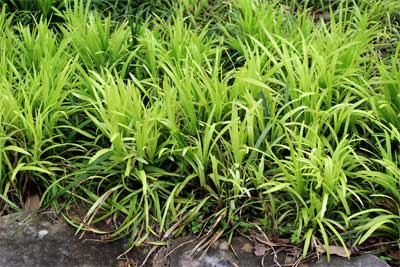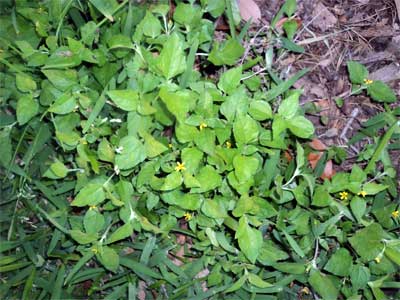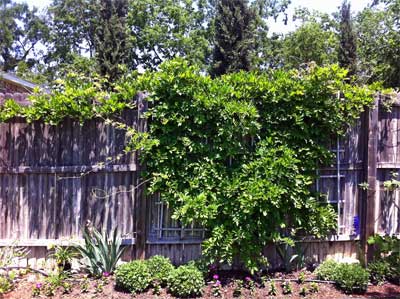Question and Answer — June 2013
I’m happy to answer questions here in e-gardens, but I do need to have a photo to fit into this format. We had a ton of questions this time, and I’ve had to choose those that I feel are of the most general reader interest. Please forgive me, but plant IDs usually are of importance only to the sender. Click here to send us your photo and the question that goes with it. Be sure to tell me your city as well, since my answer might need to be based on that information. I was surprised at how few people did mention their cities this month. I’ll do the best I can.
Question: We were told that dwarf mondograss would grow between these stepping stones in our landscape. The firm that did our landscape is now out of business. I thought I had done something wrong the first time when it died, so I replanted, but it still isn’t working, either in the shady parts or the sun. What could I use? D.W., no city given.

Answer: Dwarf mondograss is my default in my own landscape for this type of walk. I have 30 or 40 feet of it, and it’s done well for almost 30 years. However, it’s in complete shade. In the sun, I have used one of the very tiny sedum species, and it’s done fairly well. You could also use one of the smallest golf-green hybrid bermudas such as Tif-Dwarf. You’d have to trim it with the line trimmer, but it would handle the heat. You might also consider snugging the stones together and widening the bed to the right in the process. There might be an arrangement that would work well for your surface and be interesting and attractive, without all this struggle.
Question: The bark in my ‘Red Sunset’ maple is coming off in certain spots. For now the tree appears healthy. Is this any cause for concern? S.D., Metroplex.

Answer: This certainly appears to be sunscald that probably happened soon after the tree was planted. It looks like the tree is going to be able to heal itself, as judged by the roll of new bark that is forming. I do see a borer hole or two within the exposed wood, but trees can overcome those. The leaf growth will be your guide. There is nothing to do at this point. If you plant new trees elsewhere, consider wrapping their trunks with paper tree wrap for the first year or two.
Question: I planted ajuga as a groundcover last summer. It has survived and grown, but it really hasn’t spread. Isn’t it supposed to cover better than this? C.M., no city given.

Answer: It looks like your plants are doing just what they’re supposed to. Normally, I would suggest planting ajuga from 4-inch pots 6 or 8 inches apart. These plants are way too far apart. It will take them years to cover completely. You need to buy more plants of the same variety and plant three or four between each existing pair of plants. The problem for you with ajuga is that they do not produce runners. They spread simply by dividing and multiplying.
Question: I planted three live oak trees three years ago. Two have done well, but this one is turning brown and has the split in the bark. What happened, and what should I do? D.F., no city given.

Answer: Similar to the red maple question above, this looks like sunscald. Hopefully the tree can recover, although the top growth doesn’t look good. There is nothing you can do at this point except wait and watch. Use paper tree wrap to protect trunks of new oaks for a year or two after planting in future landscaping.
Question: I replaced a bed of vinca with liriope after the leafrollers wore me out. I transplanted the liriope from a bed (healthy looking) to the second location (shown). It looks like severe iron deficiency. What causes this? P.F., Willow Park.

Answer: This is a fungal crown rot that is closely related to damping off of flower seedlings and also to the dieback that happens to periwinkles. It’s a tough one to control. I had a bed that was infected with it, and I finally changed it over to mondograss. Although they’re related, mondograss, according to my experiences, does not suffer from it. Here is more than you’ll ever want to know about this disease in an extremely thorough report from the University of Florida.
Question: Is there a weedkiller we can use to kill the grass in this bed without killing the purpleheart? We have tried digging it up at the beginning of the spring, but it keeps coming back. J. and M. B., no city given.

Answer: Oh, yes! Use a product that contains glyphosate as its only active ingredient. The original Round Up is such a product. Spot-treat the grass with the glyphosate, carefully shielding the purpleheart with a piece of cardboard. Glyphosates are not active in the soil, so unless you let drift fall onto your purpleheart, it will not be affected. You could also use a foam rubber paintbrush to apply the glyphosate product directly to the bermuda. You may have to treat two or three times, but you’ll see dramatic improvements each time that you treat.
Question: How can I control this weed vine? I’ve fought it for years. L.C. East Dallas.

Answer: Snailseed vine produces several stems per plant from each very tough root system. It’s a native vine in much of the eastern half of Texas, and I’ve always found the easiest way to eliminate it is to hand-dig it with a sharpshooter spade. Once you find the crown of the plant (where the stems enter the soil), it takes only a moment to pop them out with the spade. Applying weedkillers is too risky due to the potential drift onto desirable plants.
Question: What is this lawn weed that seems to be filling every space that the drought has caused to die out? More importantly, how do I eliminate it? L.S., no city given.

Answer: This is horseherb. Although it’s used as a deciduous ground cover in woodland settings occasionally, it can quickly invade where it isn’t wanted. It’s easily eliminated with a broadleafed weedkiller spray (containing 2,4-D). Use a pump sprayer with fine droplets to cover its leaves. It should be fairly easy to eliminate.
Question: We have had three oakleaf hydrangeas in this spot for 15 years, and they have thrived. One died very suddenly a couple of weeks ago, and now a branch on the second one is dying. Help! C.N., no city given.

Answer: This has every appearance of cotton root rot, a soil-borne fungal disease. I’ve lost two to the same disease and with the same fast symptoms. Many of our landscape plants in Texas are susceptible to the disease. Curiously, it is only found in alkaline soils. It really would have helped with my answer if I had known where you live. I would suggest replacing any of the three plants that you lose with a suitable holly. They are almost immune to cotton root rot, and they are tolerant of the same amount of shade as the oakleaf hydrangeas.
Question: Why has my wisteria not bloomed for the past two springs? B.G., no city given.

Answer: I cheated on your answer. I copied-and-pasted the text from the Most Asked Questions page of my website. Here is what I have on my website:
“This is the most-asked question pertaining to vines. To say the least, it’s a common problem. Often the exact cause will be hard to determine. Factors include shade (wisterias need full sun for best flowering), excessive nitrogen (nitrogen promotes vegetative growth at the expense of flower bud production) and pruning at the wrong time (any major pruning of wisterias should be done immediately after the blooming season).”
Question: My mother recently purchased a home, and her oak tree has these things growing on it. They’re all over the tree, and the tree, as a result, is not attractive. What can she do? P., tree is in Red Oak.

Answer: These are called woody oak galls. They are caused by a wasp-like insect that stings the tree’s tissues and lays her eggs. The galls offer the developing larvae protection. Unfortunately, you can’t control the mother with insecticides unless you happen to be spraying when she flies in. She does not actually feed on the twigs, and she’s only there for a few moments. Systemic insecticides also don’t seem to help much. The problem will be worse some years than others, so don’t yank the tree out just yet.
Question: My Confederate star jasmine has recently started losing hundreds of leaves. Is it dying? M.P., no city given.

Answer: This looks like normal leaf drop of an evergreen plant. You’ll see the same thing happening to hollies, ligustrums and magnolias about the same time each spring. I have never seen an insect or disease bother this plant. It can be damaged by very cold winter weather. Otherwise, it’s pretty dependable.
Question: How can we control these seedling trees that pop up in our landscape? The one on the right has pink flowers in the spring, and it grows really rapidly. P.P., Flower Mound.

Answer: You have western soapberry on the left and redbud on the right. Both are quality trees, but they do need to be growing where you really want them. If not, they become weeds. The best way to avoid them is to mulch the bed, then cultivate or pull the seedlings as they appear each spring. These trees have grown too large to pull, but you could easily enough cut them off with a sharpshooter spade. Consider moving the redbuds next winter. They’re one of our best spring-flowering tree species.
